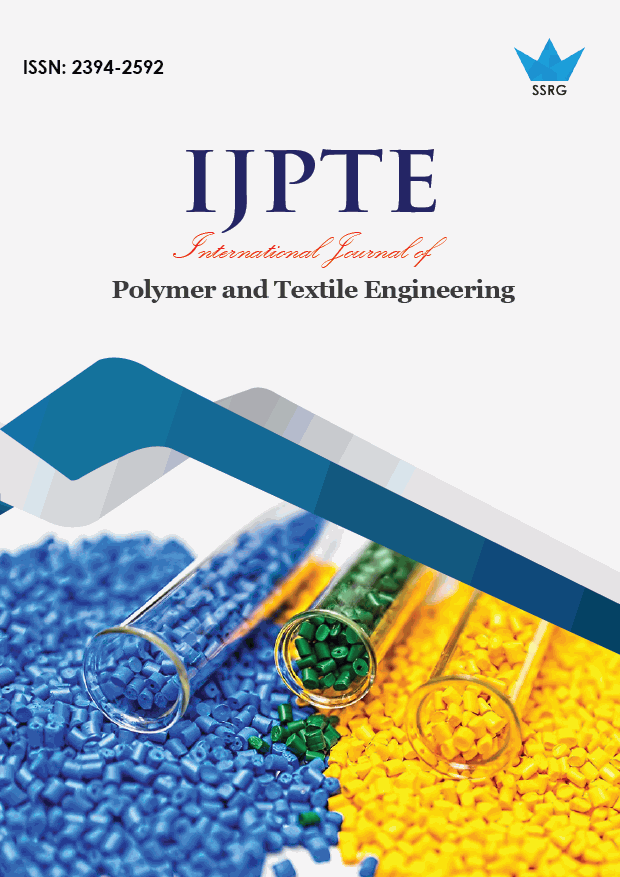Antibacterial Treatment on Cotton Fabric from Aloe Vera

| International Journal of Polymer and Textile Engineering |
| © 2020 by SSRG - IJPTE Journal |
| Volume 7 Issue 1 |
| Year of Publication : 2020 |
| Authors : Hetal Mistry, Suman Mundkur, Anju Tulshyan |
How to Cite?
Hetal Mistry, Suman Mundkur, Anju Tulshyan, "Antibacterial Treatment on Cotton Fabric from Aloe Vera," SSRG International Journal of Polymer and Textile Engineering, vol. 7, no. 1, pp. 54-58, 2020. Crossref, https://doi.org/10.14445/23942592/IJPTE-V7I1P107
Abstract:
The development of antibacterial treatment on cotton fabric using Aloe Vera extract with different finishing methods is a well-researched topic. Aloe Vera because of its rich constituents has been used in medical as well as cosmetic since ancient time. It was proved that the active ingredients of Aloe Vera are attached with the hydroxyl groups of cotton fabric via carboxylic acid cross linking agent through infrared spectra system. The objective of this study was to review previous research done by using Aloe Vera as an ingredient to improve antibacterial properties of textile material. Aloe Vera [Aloe Barbadensis Miller] was processed through hand filtered or whole leaf procedure to prepare Aloe Vera extract. Aloe Vera extract was applied on Cotton fabrics by pad-dry-cure method in different concentrations from 60% -100% for 35-60 mins at 60-80 Degree Centigrade. The antibacterial activity of Aloe Vera finished cotton fabric were qualitatively evaluated by AATCC [Agar diffusion] method and quantitative analysis test methods by most authors. The Aloe Vera extract treated cotton fabric exhibited antimicrobial activity against E. coli and S. aureus. It also found that it improves some other properties like odor control, softness and comfort. Even the washing durability showed the good results.
Keywords:
Aloe Vera, Eco-friendly, Gram Positive, Gram Negative, Natural textile finish.
References:
[1] Babiker, O., Gibril, M., Ahmed, H., Saeed, H., Mohammed, R. [2019], “Preparation of an Anti-microbial Cotton Fabric Using Synthesize Zinc Nano Particles Stabilizing by Aloe Vera Gel”, International Journal of Engineering and Information Systems, Vol. 3, Issue 4, 34-39.
[2] Afraz, N., Uddin, F., Syed, U. and Mahmood, A. [2019], “Antimicrobial Finishes for Textiles”, Current Trends in Fashion Technology and Textile Engineering, Vol. 4 Issue 5, 87- 94. [3] D. Radhika [2019], “Review Study on Antimicrobial Finishes on Textiles – Plant Extracts and Their Application”, International Research Journal of Engineering and Technology, Vol. 6 Issue 11 Nov 2019, 3581- 3588. [4] Alessandro, Caseareo [2017], “Artistic Finishes for Home Textile Materials”, SSRG International Journal of Polymer and Textile Engineering, Vol. 4 Issue 2 May to Aug 2017,1-4.
[5] Ibrahim, W., Sarwar, Z., Abid, S., Munir U. and Azeem, “A. [2017], Aloe Vera Leaf Gel Extract for Antibacterial and Softness Properties of Cotton”, Journal of Textile Science and Engineering, Vol. 7, Issue 3, 1000301.
[6] Thangamani, K., Periasamy, R. [2017], “Study on Antimicrobial Activity of Cotton”, Bamboo and Soyabean Fabrics with Herbal Finishing, International Research Journal of Pharmacy, 8 [5], 115-119.
[7] Mishra, S., Pandey, R., and Singh, M. [2016], “Development of Sanitary Napkin by Flax Carding Waste as Absorbent Core with Herbal and Antimicrobial Efficiency”, International Journal of Science, Environment and Technology, Vol.5, No 2, 404-411.
[8] Khurshid, M.F., Ayyoob, M., Asad, M. and Shah, S. N. H. [2015], “Assessment of Eco-Friendly Natural Antimicrobial Textile Finish Extracted from Aloe Vera and Plants”, Fibres and Textiles in Eastern Europe, 23, 6 [114], :120-123.
[9] Wazed, Ali S., Purwar, R., Joshi, M. and Rajendran, S. [2014], “Antibacterial Properties of Aloe Vera Gel-Finished Cotton Fabric”, Cellulose 21, Issue 3, 2063- 2072.
[10] Hein, N., Hnin, S. and Htay, D. [2013], “A Study on the Effect of Antimicrobial Agent from Aloe Vera Gel on Bleached Cotton Fabric”, International Journal of Emerging Technology and Advanced Engineering, Vol. 4, Issue 2, 7-11.
[11] Malpani, S. [2013], “Antibacterial Treatment on Cotton Fabric from Neem Oil, Aloe Vera and Tulsi”, International Journal of Advance Research in Science and Engineering, Vol. No.2, Issue No. 7, 35-43.
[12] Dr. Khan, A.F. [2012], “Extraction, Stabilisation and Application of Antimicrobial Agents from Aloe Vera”, Lambert Academic Publication, 66121, 6-8.
[13] Consery, J. [2012], “Evaluation of antimicrobial efficacy of Aloe vera and its effectiveness in decontaminating gutta percha cones”, Journal of Conservative Dentistry, 15[3]: 246–248.
[14] Prathiban, M., Srikrishnan, M. R. and Viju, S. [2011], Odor “Retention and Antibacterial Efficacy of Non Woven Fabrics for Technical Textile Applications”, International Journal of Pharmacy and Life Science, Vol. 2, Issue 10, 1137-1141.
[15] Selvi Thamarai B., Rajendren R., Nithyalakshmi B. and Gayathirignaneswari S. [2011], Antimicrobial Activity of Cotton Fabric Treated with Aloevera Extract, International Journal of Applied Environmental Sciences, 6 [2], 127-131.
[16] Joshi, M., Wazed, Ali S. and Purwar, R. [2009], have reviewed Ecofriendly antimicrobial finishing of textile using bioactive agents based on natural products, Indian Journal of Fibre and Textile Research, Vol. 34, 295-304.
[17] Jothi, D. [2009], Experimental study on antimicrobial activity of cotton fabric treated with aloe vera gel extract from Aloe vera plant for controlling the Staphylococcus aureus [bacterium], African Journal of Microbiology Research, Vol. 3 [5], 228-232.
[18] Raj Kumar, G. and Krishnaveni, V. [2007], An Eco Friendly Herbal Antimicrobial Finish on Cotton Fabric Using Aloe Barbadensis Miller [Aloe Vera], Man-Made Textiles in India, 50 [4],:145-149.

 10.14445/23942592/IJPTE-V7I1P107
10.14445/23942592/IJPTE-V7I1P107